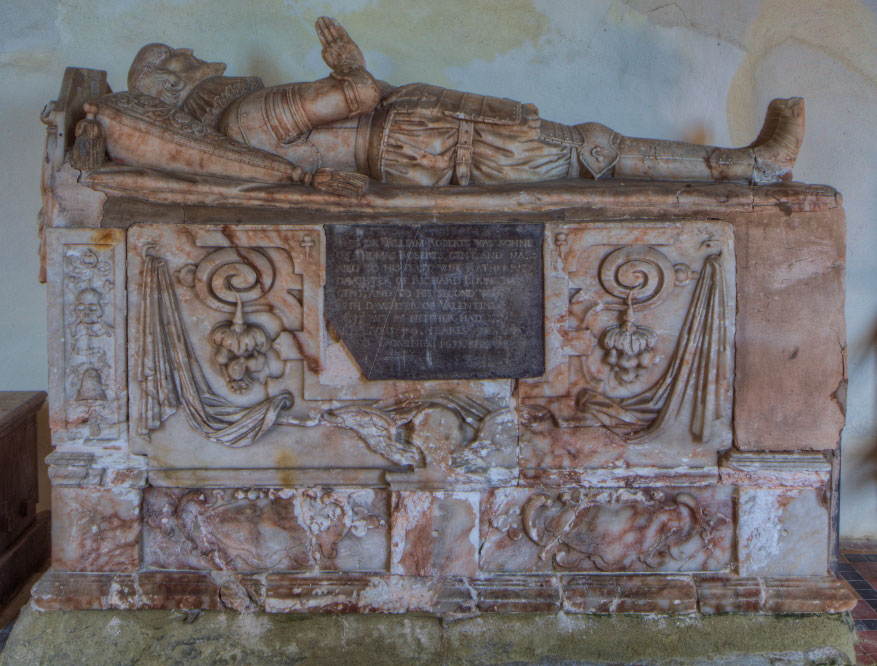
Sutton Cheney monument to William Roberts who died without issue
This pretty village has a population of around 550 and is 14 miles west of Leicester and very near to the Battle of Bosworth which occurred in 1485. There will be a section on the battle added to the site soon – in the meantime I have added a link to Bosworth Battlefield site further down.
Before and after the Norman Conquest the major part of the manor (including a windmill) was owned by the Abbey of Croyland in Lincolnshire. A later rich tenant farmer named Chainell looked after the Abbeys land and this gave rise eventually to its modern name of Sutton Cheney.
By 1279 the village had three distinct manors of Verdon (Theobald de Verdon), Hastings (John Hastings) and Croyland. The Hastings manor passed to a Gilbert de Houby in 1292. By 1564 there were 25 families living at Sutton Cheynell, an Elizabeth Beler, daughter and heir of Anthony Houby, was married to James Beler of Kettleby. In 1630 the freeholders were William Roberts (knight), Richard May, William Drakeley and John Swinfen. Sir William Roberts had a manor house at Sutton and he founded a hospital for six poor people and endowed it with 30 pounds a year. The charitable building built of stone is still there today to the east of the church as a pretty private dwelling.
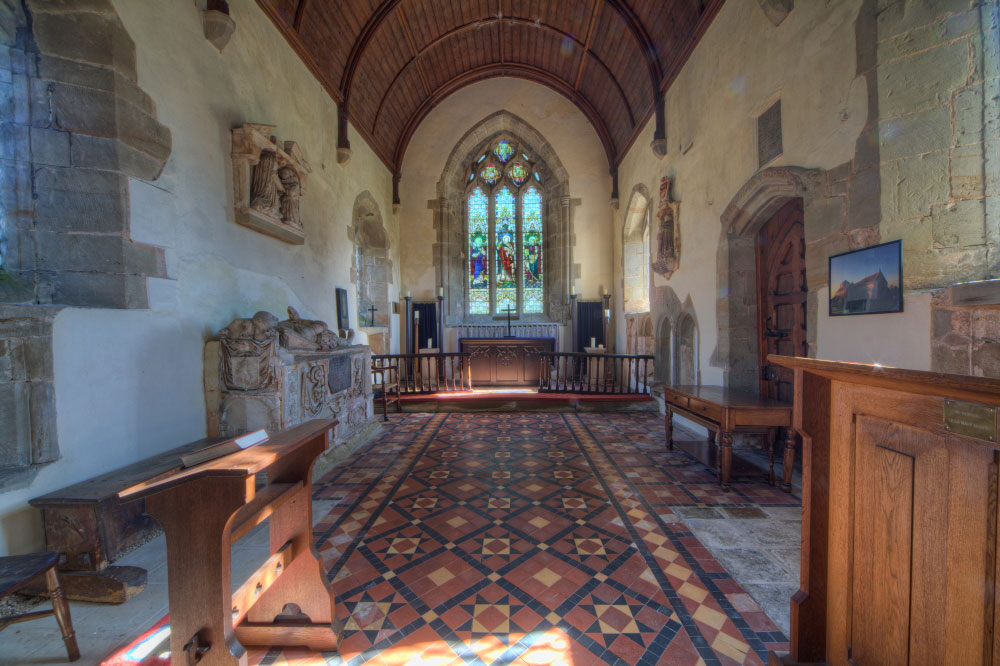
14th century chancel with monuments and restored Victorian tiles and roof
In the Civil War the Roberts family supported the Royalist cause and experienced some harassment by the Parliamentarian Sequestrators and had to pay them a sum of 780/ shillings.
“Sept. 3, 1646. Resolved. That this House doth accept of the sum of 780/. of William Roberts
the younger, of Sutton Cheney in the county of Leicester, gentleman, for a fine for his delinquency. His offence is, leaving his own house, and residing in the enemy’s garrisons. An Ordinance for granting a pardon unto William Roberts the younger, of Sutton Cheney in the county of Leicester, gentleman, for his delinquency, was this day read; and, upon the
question, passed; and ordered to be sent unto the Lords for their concurrence.”
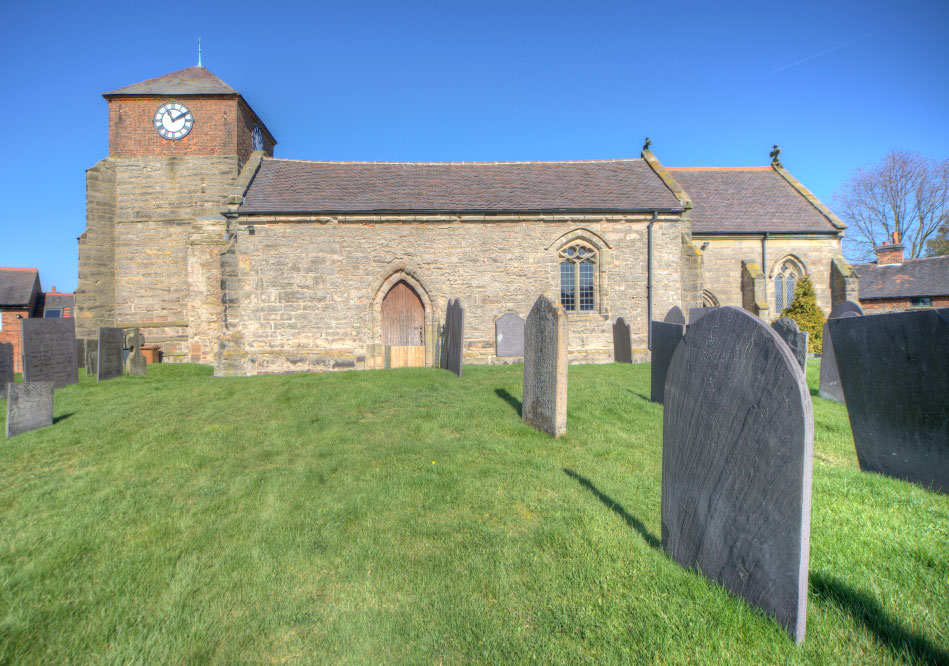
The gabled south aisle and the low tower today
The church of St James mostly dates from the 14th century and probably replaces an earlier church on the site. The church consists of a low west tower, nave, chancel and south chapel. The circular arcade dates to the 13th century, the low west tower has a brick upper stage which was rebuilt in the early 19th century. The font is probably 14th century.
There is a monument to William Roberts who died in 1633 a recumbent alabaster effigy. He lies in armour with his two wives, one kneeling at his feet. The inscription reads; “here lyeth interred the body of Sir William Roberts, who in his life-time, being devoted both to hospitality and charity, among other memorable works erected, out of a pious mind, a hospital for six poor men adjoining the churchyard and endowed it with 30 pounds worth of land yearly for their maintenance for ever”.
On the other side it reads, “Sir William Roberts was son of Thomas Roberts and married to his first wife Katherine, daughter of Richard Elkington, and to his second wife Elizabeth, daughter of Valentine Hartopp; but by neither had issue. He lived 79 years and died Feb 24 1633.”
The tomb seems to have suffered some damage but is still an interesting piece.
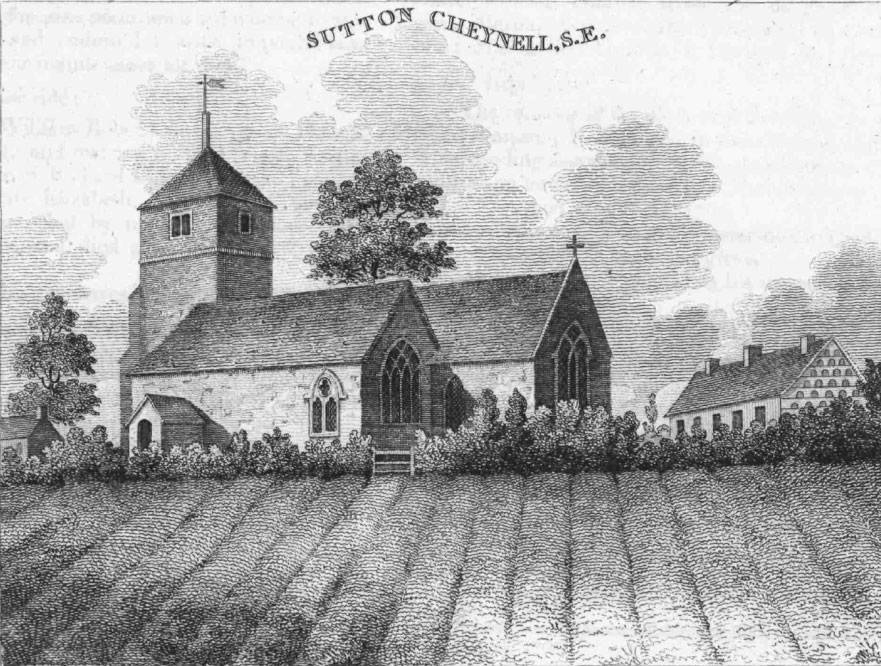
Engraving from Nichols late 18th century, the porch has now gone
The church has been restored but it still has enough items of interest to make it worth a visit. It has some box pews and of course the tradition that Richard III heard his last Mass in this church. The Richard III Society holds a commemorative service here each year on the Sunday closest to the anniversary of the battle. Many of the needlepoint kneelers in the church are the work of members of the Richard III Society, in England and abroad.
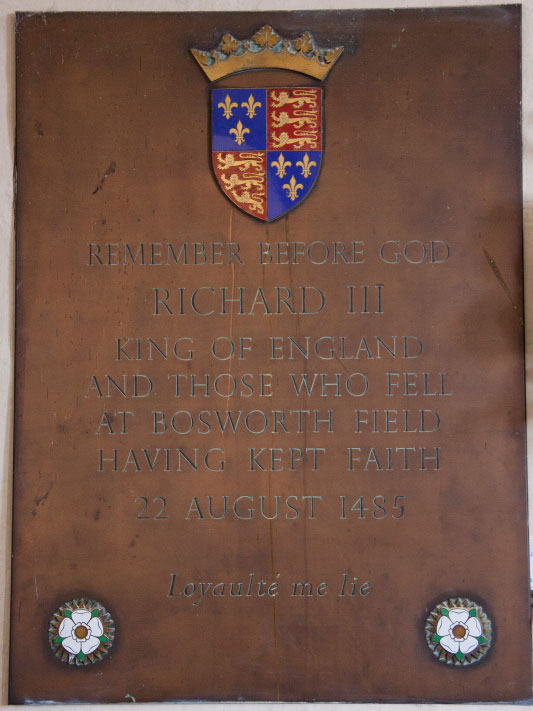
Richard III Memorial Plaque
There was (and perhaps still is although I could not see it) a headstone to the mathematician Thomas Simpson in the churchyard who died in 1761. “The remains of the Bosworth Prodigy, Thomas Simpson, F.R.S rest in this churchyard. After rending asunder the fetters of indigence, he arose to an envied eminence as a Mathematician and died A.D 1761.”
He was born in Market Bosworth the son of a self-taught weaver, he was expected to follow his father’s footsteps but after viewing the solar eclipse in 1724 he turned to mathematics. He became a lecturer in the coffee houses of London and wrote several important texts.
The church’s tower is unusual and it can be seen from the engraving from the 1790’s that the original tower was higher. The church is usually open at weekends and there is a great pub just across the road called the Hercules which has a very interesting history and I attach a link to the historical data.
View Leicestershire & Rutland Churches 01 in a larger map



June 23, 2014
The church is now open every day and the pub is open again
March 2, 2019
I look very
forward to to coming up to Sutton Cheney,
and to visiting
St. James’s Church in Leics.
Princess Maria Sviatopolk-Mirski/London.
March 7, 2019
Thank you. I am look very forward to coming up to Sutton Cheney
some time in early May.
Princess Maria Sviatopolk-Mirski
June 23, 2014
Good to hear the church is open and the pub has re-opened
October 19, 2021
I Bernard i am Marie Juby mother of Paul Juby that you already met many years ago when he was in England he went to see you. He as cancer but fighting it.we still leave in Montreal.take care
October 4, 2015
Good to see my ancestor mentioned here. The de Houby family (now spelt pnonetically as Juby) owned the Manors of Houby (now Hoby), Sutone Cheynill (now Sutton Cheyney) and Anabein(now Ambion Hill). I am the current Lord of the Manor of Hoby.
March 7, 2017
I’m looking for the Fanthom family from Sutton chenney please can someone help me
March 7, 2017
Looking for Fanthom family from suton chenney please can someone help me please a William Fanthom born there about 1871 tried a Edith possible Henderson from staffs
August 3, 2018
Hi
Ian Steven
I’m researching my mums family her name is Linda woolman( cooper) born Markfield lane Markfield Leicester born 1941 father Ernest cooper born 1907 Ashby road Markfield father Joseph cooper born 1875 blacksmith he married a Mary Helena Massey Markfield mother ann cooper ( brooks Markfield ) father Abraham cooper born 1841 Markfield father Charles cooper born 1800 Barlestone father Thomas mother Mary cooper ( ward) I was told that the coopers are in Sutton Cheney church yard behind the evert family..
Please can some go and have a look for me .
Thanks
Steven
March 22, 2019
I am reseaching into the life of Emily Chesshire nee Izon whose mother Charlotte Smith came from Sutton Cheyney. Her brother Richard Smith lived in the manor house in 1846 and was described as a brazier. Would love to know more about him
October 12, 2019
Hi
We are visiting Sutton Cheney this weekend as I am doing a bit of family history research.
My mother was married in the Parish Church there in 1943 and her birth certificate states she was born in in Sutton Cheney so she was presumably baptized there too. (she died when I was just 13 months old so I have few details).
From their marriage certificate, I can see that when they were married they were both living in Sutton Cheney and were munitions workers.
Do you have any idea where they would have been working exactly?. I presume there was a munitions factory nearby.
December 31, 2019
FYI The memorial to Thomas Simpson is not a headstone but a memorial plaque in Latin on the inside wall of the church to the left of the door.